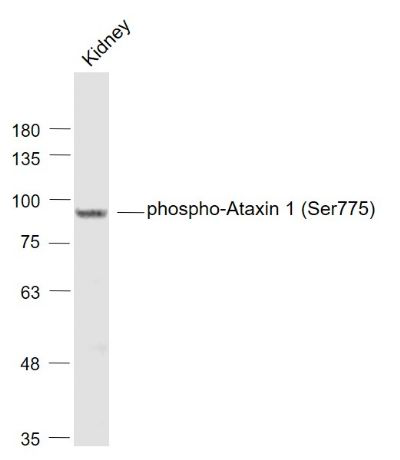产品货号 : mlR12534
英文名称 : phospho-Ataxin 1 (Ser775)
中文名称 : 磷酸化脊髓小脑失调症蛋白1抗体
别 名 : Ataxin 1 (phospho Ser776);p-Ataxin 1 (phospho S776); ATX1; ATXN1; SCA1; Ataxin 1; Ataxin-1; Ataxin1; Spinocerebellar ataxia type 1; ATX1_HUMAN.
产品类型 : 磷酸化抗体
研究领域 : 细胞生物 神经生物学 表观遗传学
抗体来源 : Rabbit
克隆类型 : Polyclonal
交叉反应 : Human, Mouse, Rat, Chicken, Dog, Pig, Cow, Horse, Rabbit, Sheep,
产品应用 : WB=1:500-2000 ELISA=1:500-1000 IHC-P=1:400-800 IHC-F=1:400-800 ICC=1:100-500 IF=1:100-500 (石蜡切片需做抗原修复)
not yet tested in other applications.
optimal dilutions/concentrations should be determined by the end user.
分 子 量 : 87kDa
细胞定位 : 细胞核 细胞浆
性 状 : Lyophilized or Liquid
浓 度 : 1mg/ml
免 疫 原 : KLH conjugated synthesised phosphopeptide derived from human Ataxin 1 around the phosphorylation site of Ser776:RW(p-S)AP
亚 型 : IgG
纯化方法 : affinity purified by Protein A
储 存 液 : 0.01M TBS(pH7.4) with 1% BSA, 0.03% Proclin300 and 50% Glycerol.
保存条件 : Store at -20 °C for one year. Avoid repeated freeze/thaw cycles. The lyophilized antibody is stable at room temperature for at least one month and for greater than a year when kept at -20°C. When reconstituted in sterile pH 7.4 0.01M PBS or diluent of antibody the antibody is stable for at least two weeks at 2-4 °C.
PubMed : PubMed
产品介绍 : Ataxin-1, also designated spinocerebellar ataxia type 1 protein (Sca-1), is differentially expressed and localizes to both the cytoplasm and the nucleus. Mutations in Ataxin-1 are associated with the onset of the autosomal dominant neurodegenerative disorder spinocerebellar ataxia type 1 (SCA-1), which is characterized by progressive neuronal loss in the cerebellum, muscle wasting and ataxia. In Purkinje cells, where SCA-1 is predominantly observed, Ataxin-1 has been shown to directly associate with the Purkinje-enriched leucine-rich acidic nuclear protein (LANP) and the nuclear matrix-associated protein promyelocytic leukemia protein PML. In SCA-1, Ataxin-1 is mutated to encode a polyglutamine protein that forms nuclear aggregates, which interact significantly more strongly with LANP and contribute to the pathogenesis of SCA-1.
Function:
Binds RNA in vitro. May be involved in RNA metabolism. The expansion of the polyglutamine tract may alter this function.
Subunit:
Homooligomer. Interacts with CIC (By similarity). Interacts with ANP32A, PQBP1, UBQLN4, ATXN1L, USP7 and ZNF804A. Directly interacts with RBPJ; this interaction is disrupted in the presence of Notch intracellular domain. Competes with ATXN1L for RBPJ-binding.
Subcellular Location:
Cytoplasm. Nucleus. Colocalizes with USP7 in the nucleus.
Tissue Specificity:
Widely expressed throughout the body.
Post-translational modifications:
Phosphorylation at Ser-775 increases the pathogenicity of proteins with an expanded polyglutamine tract.
Sumoylation is dependent on nuclear localization and phosphorylation at Ser-775. It is reduced in the presence of an expanded polyglutamine tract.
DISEASE:
Defects in ATXN1 are the cause of spinocerebellar ataxia type 1 (SCA1) [MIM:164400]; also known as olivopontocerebellar atrophy I (OPCA I or OPCA1). Spinocerebellar ataxia is a clinically and genetically heterogeneous group of cerebellar disorders. Patients show progressive incoordination of gait and often poor coordination of hands, speech and eye movements, due to cerebellum degeneration with variable involvement of the brainstem and spinal cord. SCA1 belongs to the autosomal dominant cerebellar ataxias type I (ADCA I) which are characterized by cerebellar ataxia in combination with additional clinical features like optic atrophy, ophthalmoplegia, bulbar and extrapyramidal signs, peripheral neuropathy and dementia. SCA1 is caused by expansion of a CAG repeat in the coding region of ATXN1. Longer expansions result in earlier onset and more severe clinical manifestations of the disease.
Similarity:
Belongs to the ATXN1 family.
Contains 1 AXH domain.
SWISS:
P54253
Gene ID:
6310
Important Note:
This product as supplied is intended for research use only, not for use in human, therapeutic or diagnostic applications.
产品图片












